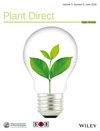栽培向日葵(Helianthus annuus L.)对中度干旱胁迫的耐受性低于同种野生向日葵,但其基本特性仍然难以捉摸
IF 2.3
3区 生物学
Q2 PLANT SCIENCES
引用次数: 0
摘要
一般认为,与野生近缘植物相比,栽培作物对非生物胁迫的耐受力较弱。然而,这一假设并没有得到实证文献的充分支持,而且可能取决于胁迫的类型和施加方式,以及所使用的耐受性衡量标准。在此,我们研究了Helianthus annuus的野生和栽培品种在抗逆性方面是否存在差异,抗逆性是指干旱导致生物量下降的比例,以及野生和栽培品种在对干旱的性状反应和性状与抗逆性的关联方面是否存在差异。在一项温室研究中,两个驯化等级的鹅掌楸品种(8 个栽培品种和 8 个野生品种)接受了两种处理:水分充足的对照组和中度干旱组,中度干旱组是在干枯后通过自动灌溉将土壤水分维持在预定水平。处理在幼苗期进行,植物在处理两周后收获。栽培品种对干旱的生物量下降比例为 24%,而野生品种的下降比例并不明显。因此,用生物量下降比例来衡量,栽培品种的耐旱性较差。在对照处理中,耐旱性与以生物量评估的活力之间没有权衡。在多元分析中,野生品种和栽培品种在形态、生理和分配性状方面没有差异,对干旱的反应也没有差异。单独分析发现,野生和/或栽培品种的性状对干旱的反应各不相同,包括比叶面积、叶片理论最大气孔导度(gsmax)和气孔孔隙长度的下降,但气孔密度、多汁性或渗透调节能力没有处理反应。从性状与耐受性的关系来看,gsmax 的可塑性最令人感兴趣,因为它与耐受性的关系因驯化等级而异(尽管影响相对较弱),因此可能导致栽培向日葵的耐受性较低。我们对向日葵的研究结果表明,在某些条件下,农作物的抗逆性低于野生近缘植物。然而,确定野生向日葵和栽培向日葵之间中等耐旱性差异的关键性状仍是一个未知数。本文章由计算机程序翻译,如有差异,请以英文原文为准。
Cultivated sunflower (Helianthus annuus L.) has lower tolerance of moderate drought stress than its con‐specific wild relative, but the underlying traits remain elusive
Cultivated crops are generally expected to have less abiotic stress tolerance than their wild relatives. However, this assumption is not well supported by empirical literature and may depend on the type of stress and how it is imposed, as well as the measure of tolerance being used. Here, we investigated whether wild and cultivated accessions of Helianthus annuus H. annuus H. annuus smax ), and stomatal pore length, but there was no treatment response for stomatal density, succulence, or the ability to osmotically adjust. Focusing on traits associations with tolerance, plasticity in gsmax was the most interesting because its association with tolerance differed by domestication class (although the effects were relatively weak) and thus might contribute to lower tolerance of cultivated sunflower. Our H. annuus H. annuus
求助全文
通过发布文献求助,成功后即可免费获取论文全文。
去求助
来源期刊

Plant Direct
Environmental Science-Ecology
CiteScore
5.00
自引率
3.30%
发文量
101
审稿时长
14 weeks
期刊介绍:
Plant Direct is a monthly, sound science journal for the plant sciences that gives prompt and equal consideration to papers reporting work dealing with a variety of subjects. Topics include but are not limited to genetics, biochemistry, development, cell biology, biotic stress, abiotic stress, genomics, phenomics, bioinformatics, physiology, molecular biology, and evolution. A collaborative journal launched by the American Society of Plant Biologists, the Society for Experimental Biology and Wiley, Plant Direct publishes papers submitted directly to the journal as well as those referred from a select group of the societies’ journals.
 求助内容:
求助内容: 应助结果提醒方式:
应助结果提醒方式:


